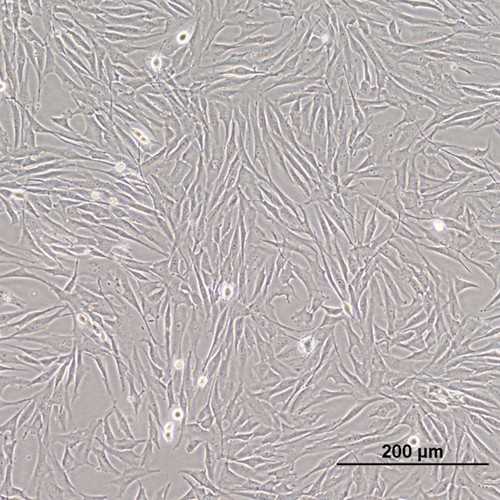Canine Osteosarcoma Cell Line (OSCA-32)
OSCA-32 is a canine osteosarcoma cell line derived from a tumor in the left wrist of a 9-year old spayed female Great Pyrenees.
Highlights:
- Grows in vitro and forms orthotopic tumor xenografts in immunodeficient mice
- Gene expression profile is consistent with that observed in the less aggressive molecular phenotype of osteosarcoma
Osteosarcomas are aggressive malignant neoplasia that arise from primitive transformed cells of mesenchymal origin (and thus a sarcoma) and exhibit osteoblastic differentiation and produce malignant osteoid.
From the laboratory of Jaime F. Modiano, VMD, PhD, University Minnesota, Twin Cities.
OSCA-32 is a canine osteosarcoma cell line derived from a tumor in the left wrist of a 9-year old spayed female Great Pyrenees.
Highlights:
- Grows in vitro and forms orthotopic tumor xenografts in immunodeficient mice
- Gene expression profile is consistent with that observed in the less aggressive molecular phenotype of osteosarcoma
Osteosarcomas are aggressive malignant neoplasia that arise from primitive transformed cells of mesenchymal origin (and thus a sarcoma) and exhibit osteoblastic differentiation and produce malignant osteoid.
From the laboratory of Jaime F. Modiano, VMD, PhD, University Minnesota, Twin Cities.
This product is for sale to Nonprofit customers only. For profit customers, please Contact Us for more information.
Specifications
| Product Type: | Cell Line |
| Name: | OSCA-32 |
| Cell Type: | Osteosarcoma |
| Morphology: | Spindle |
| Source: | Bone (radius) |
| Organism: | Dog |
| Biosafety Level: | 2 |
| Growth Conditions: | DMEM, 10mM HEPES, 10% FBS, 100ug/mL Primocin |
| Subculturing: | Doubling time approx. 22 hr |
| Cryopreservation: | 90%FBS/10% DMSO |
| Mycoplasma Tested: | Yes |
| Storage: | Liquid nitrogen |
| Shipped: | Dry ice |
Documentation
Provider
From the laboratory of Jaime F. Modiano, VMD, PhD, University Minnesota, Twin Cities.
References
- Scott MC, Sarver AL, Gavin KJ, Thayanithy V, Getzy DM, Newman RA, Cutter GR, Lindblad-Toh K, Kisseberth WC, Hunter LE, Subramanian S, Breen M, Modiano JF. Molecular subtypes of osteosarcoma identified by reducing tumor heterogeneity through an interspecies comparative approach. Bone. 2011 Sep;49(3):356-67. doi: 10.1016/j.bone.2011.05.008. Epub 2011 May 15.
- Modiano JF, Bellgrau D, Cutter GR, Lana SE, Ehrhart NP, Ehrhart E, Wilke VL, Charles JB, Munson S, Scott MC, Pozniak J, Carlson CS, Schaack J, Duke RC. Inflammation, apoptosis, and necrosis induced by neoadjuvant fas ligand gene therapy improves survival of dogs with spontaneous bone cancer. Mol Ther. 2012 Dec;20(12):2234-43. doi: 10.1038/mt.2012.149. Epub 2012 Jul 31.
- Cannon CM, Pozniak J, Scott MC, Ito D, Gorden BH, Graef AJ, Modiano JF. Canine osteosarcoma cells exhibit resistance to aurora kinase inhibitors. Vet Comp Oncol. 2015 Mar;13(1):48-59. doi: 10.1111/vco.12018. Epub 2013 Feb 15.
- Murahari S, Jalkanen AL, Kulp SK, Chen CS, Modiano JF, London CA, Kisseberth WC. Sensitivity of osteosarcoma cells to HDAC inhibitor AR-42 mediated apoptosis. BMC Cancer. 2017 Jan 21;17(1):67. doi: 10.1186/s12885-017-3046-6. PubMed PMID: 28109246; PubMed Central PMCID: PMC5251323.
- Scott MC, Tomiyasu H, Garbe JR, Cornax I, Amaya C, O'Sullivan MG, Subramanian S, Bryan BA, Modiano JF. Heterotypic mouse models of canine osteosarcoma recapitulate tumor heterogeneity and biological behavior. Dis Model Mech. 2016 Dec 1;9(12):1435-1444. Epub 2016 Nov 3. PubMed PMID: 27874835; PubMed Central PMCID: PMC5200896.
- Fenger JM, Roberts RD, Iwenofu OH, Bear MD, Zhang X, Couto JI, Modiano JF, Kisseberth WC, London CA. MiR-9 is overexpressed in spontaneous canine osteosarcoma and promotes a metastatic phenotype including invasion and migration in osteoblasts and osteosarcoma cell lines. BMC Cancer. 2016 Oct 10;16(1):784. PubMed PMID: 27724924; PubMed Central PMCID: PMC5057229.
- Scott MC, Sarver AL, Tomiyasu H, Cornax I, Van Etten J, Varshney J, O'Sullivan MG, Subramanian S, Modiano JF. Aberrant Retinoblastoma (RB)-E2F Transcriptional Regulation Defines Molecular Phenotypes of Osteosarcoma. J Biol Chem. 2015 Nov 20;290(47):28070-83. doi: 10.1074/jbc.M115.679696. Epub 2015 Sep 16. PubMed PMID: 26378234; PubMed Central PMCID: PMC4653667.
- Im KS, Graef AJ, Breen M, Lindblad-Toh K, Modiano JF, Kim JH. Interactions between CXCR4 and CXCL12 promote cell migration and invasion of canine hemangiosarcoma. Vet Comp Oncol. 2017 Jun;15(2):315-327. doi: 10.1111/vco.12165. Epub 2015 Sep 3. PubMed PMID: 26337509.
- Lin W, Modiano JF, Ito D. Stage-specific embryonic antigen: determining expression in canine glioblastoma, melanoma, and mammary cancer cells. J Vet Sci. 2017 Mar 30;18(1):101-104. doi: 10.4142/jvs.2017.18.1.101. PubMed PMID: 27456773; PubMed Central PMCID: PMC5366293.
If you publish research with this product, please let us know so we can cite your paper.


